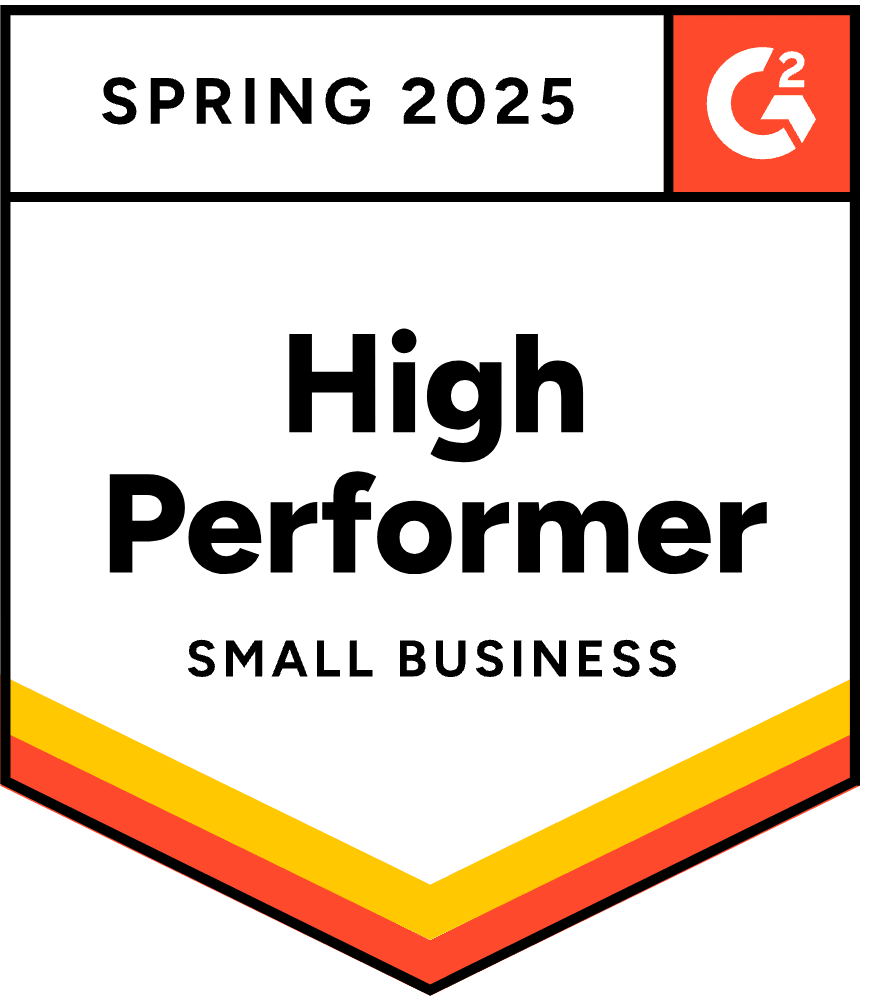- Blog
- How to Get Started With a Personalization Quiz (& Examples)
How to Get Started With a Personalization Quiz (& Examples)
Table of Contents
Ever feel like your customers are bouncing off your site before they even get to the good stuff? You’ve got great products, a solid brand… but conversions? Meh.
Here’s a secret weapon: a personalization quiz.
We’re not talking fun little Q&As—these are strategic quizzes designed to guide your visitors, help you learn about their preferences, and serve up exactly what they’re looking for. When done right, a personalization quiz boosts engagement, captures leads, and improves the overall user experience.
Let’s dive in and see how you can build one that actually works (and snag some real-world inspiration while we’re at it).
What is a personalization quiz?
A personalization quiz is a short, interactive questionnaire that your website visitors fill out to receive tailored product recommendations. Think of it like a digital personal shopper—one that’s data-driven and scalable.
Here’s the beauty of it: while customers get a personalized experience, you get zero-party data straight from them. No third-party guesswork.
By collecting insights based on answers they willingly give you, you can create a truly personalized experience for them.
How to build a personalized quiz?
Creating a personalization quiz isn’t rocket science—but it’s also not a free-for-all. The most successful quizzes are intentional, strategic, and deeply user-focused.
When done right, they feel less like a sales funnel and more like a helpful conversation.
Here’s what to do if you want people to engage and convert:
1. Keep it short and snappy
Long quizzes kill momentum. Most users aren’t signing up for a deep-dive personality profile—they just want fast, relevant suggestions.
Stick to 3 to 5 questions that give you just enough insight to personalize their experience without overwhelming them. Every extra click should earn its keep.
2. Focus on flow
A quiz should feel like it’s reading your mind—not making you work. That means a logical progression of questions, consistent language, and smooth transitions.
If a question feels out of place or jarring, it can break the user’s rhythm and cause drop-off. Map the journey before you build.
3. Limit your product recommendations
Don’t make people scroll through a wall of options. A few curated picks—based on their quiz answers—feel more personalized and help reduce analysis paralysis.
Less is more… when it’s relevant. Presenting concise quiz results not only enhances the user experience but also ensures that the recommendations feel truly tailored to their needs.
4. Show personalized recommendations
This is where the magic happens. Use the data users give you to tailor their results. That means personalized messaging (“Based on your answers, we recommend…”), visuals that match their preferences, and products that align with their goals. If it feels generic, you’re doing it wrong.
5. Add visual appeal
Design matters. Visual elements like product photos, icons, or illustrations not only make your quiz more engaging, but also guide the eye and reinforce your brand. Aim for clean, responsive design that feels like a native part of your site.
6. Optimize for mobile
This one’s non-negotiable. The majority of your audience is probably taking the quiz on their phones, so test the mobile experience thoroughly. Buttons should be easy to tap, text should be readable, and loading times should be lightning-fast.
9 real-life e-commerce personalization quiz examples
Need a bit of inspiration before building your own quiz? These nine brands didn’t just create quizzes—they crafted experiences that pulled people in, captured valuable data, and converted like crazy.
Here’s how they did it (and how you can, too):
1. Mechanism
Mechanism hooked quiz takers with one simple, targeted question: Are you team Nintendo, PlayStation, or Xbox? This first step isn’t random—it’s strategic. It grabs attention while instantly segmenting users based on interest.
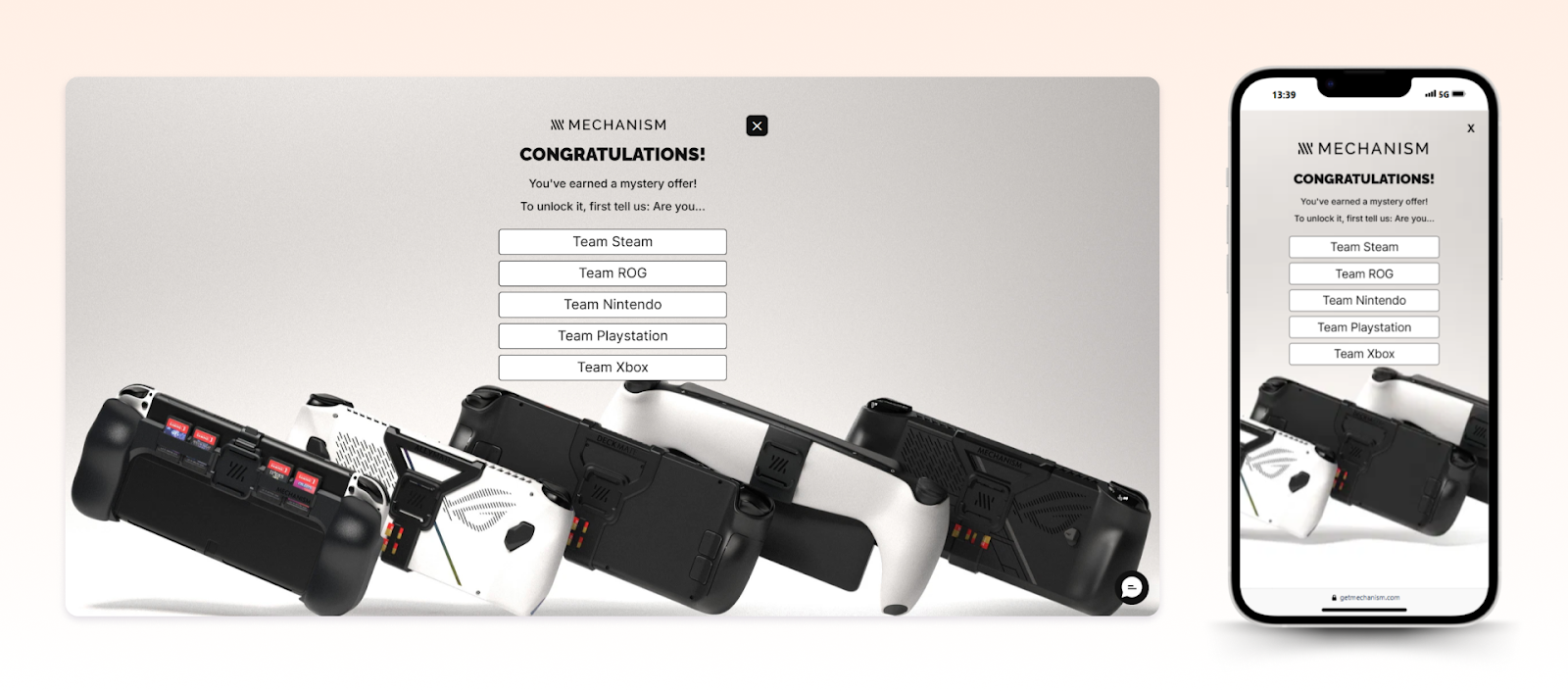
After that, they invited users to share their email to reveal their results. The offer of personalized recommendations—paired with a touch of mystery—made opting in feel natural.
See how Mechanism used a simple quiz to drive email signups and sales.
2. Loop Earplugs
Loop Earplugs doesn’t just sell noise-canceling accessories—they sell personalized sound solutions. And they make that clear from the moment you land on their site.
Above the fold on their homepage, Loop features a quiz that acts as a secondary call-to-action (CTA). It’s also easily accessible from the site menu, ensuring users see it right away.
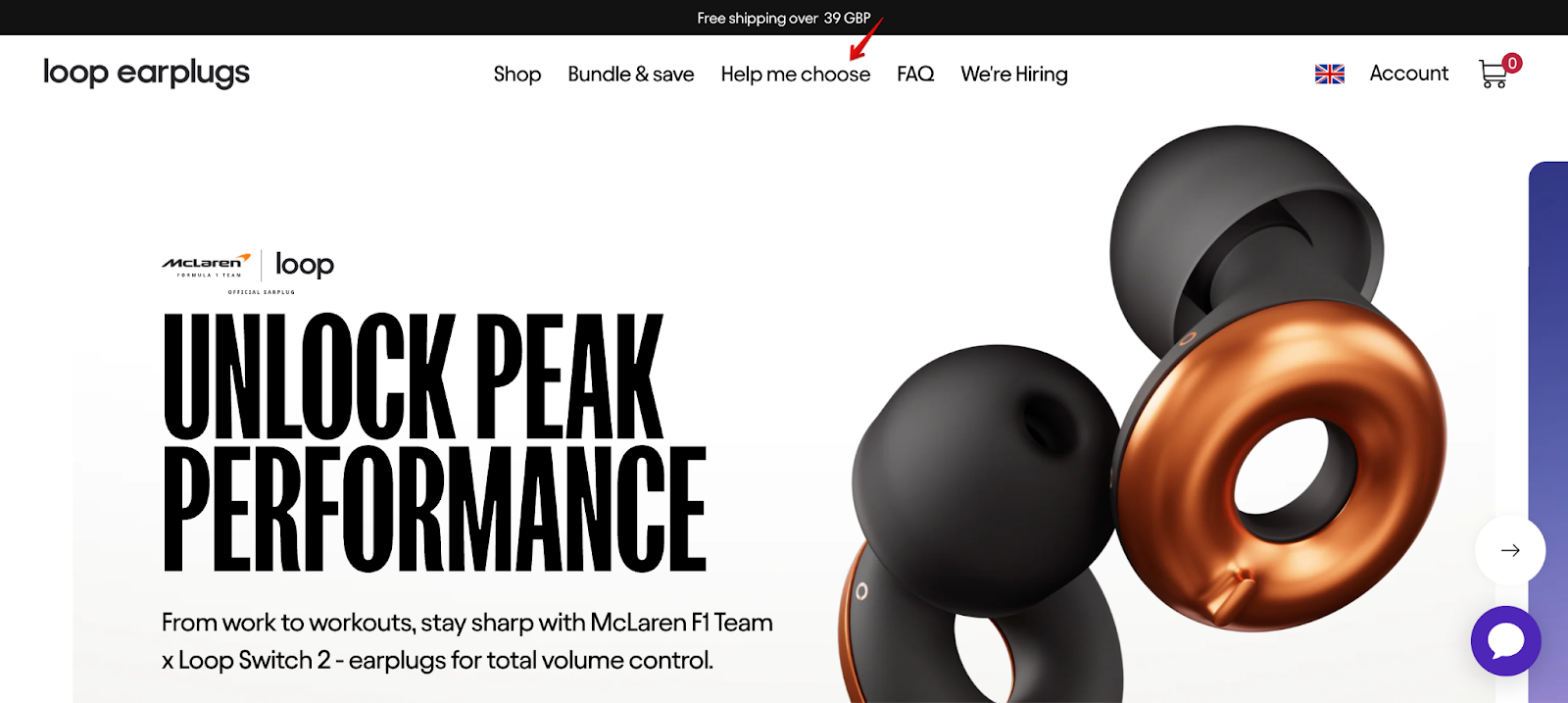
The idea? Help visitors quickly find the best earplugs for their needs—whether it’s for sleep, concerts, or focus.
The quiz is laser-focused. It asks targeted questions about the user’s lifestyle, environment, and preferences.
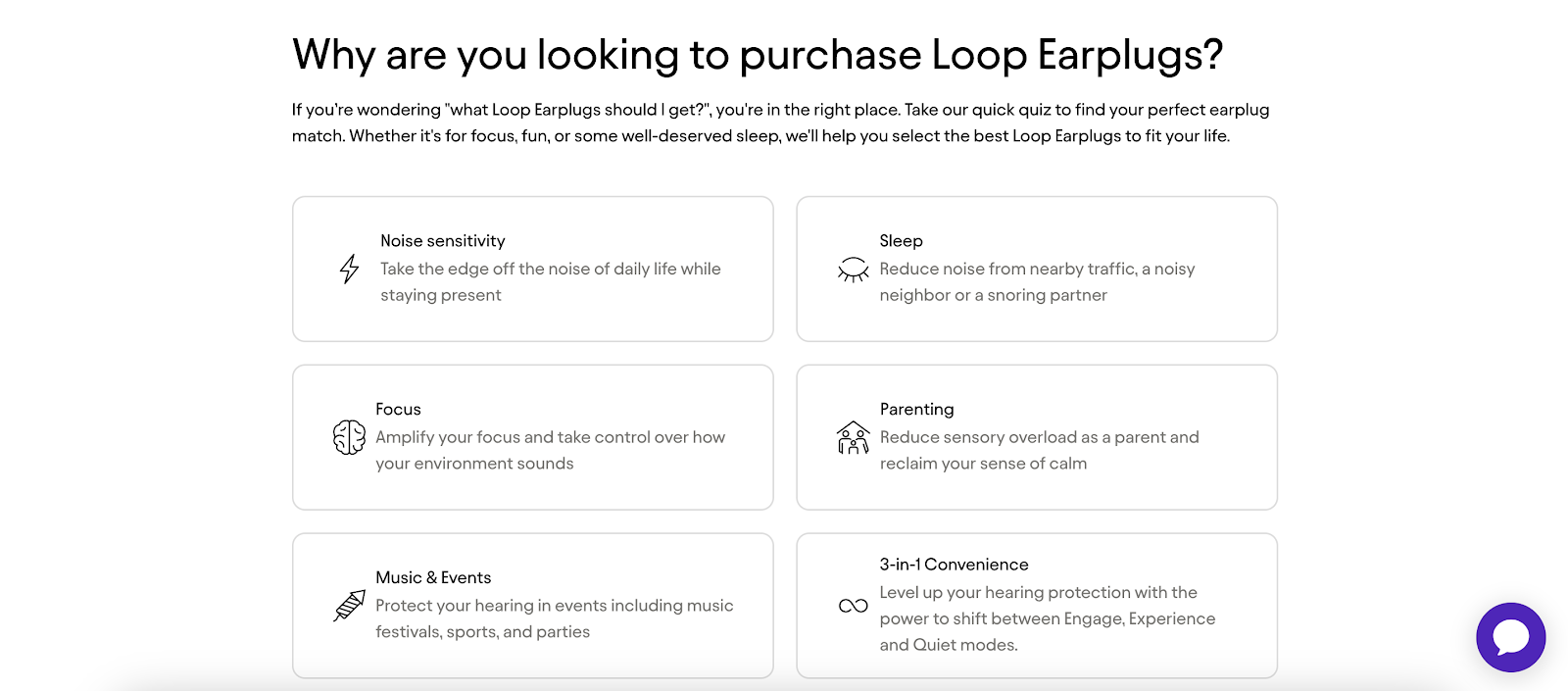
See how Loop turns a simple quiz into a confident buying decision—read the full breakdown here.
3. Desert Does It
Desert Does It took a subtle but powerful approach by embedding a multi-step quiz in a popup. No intrusive forms—just a clean, conversational flow.
It starts with a simple yes/no question.
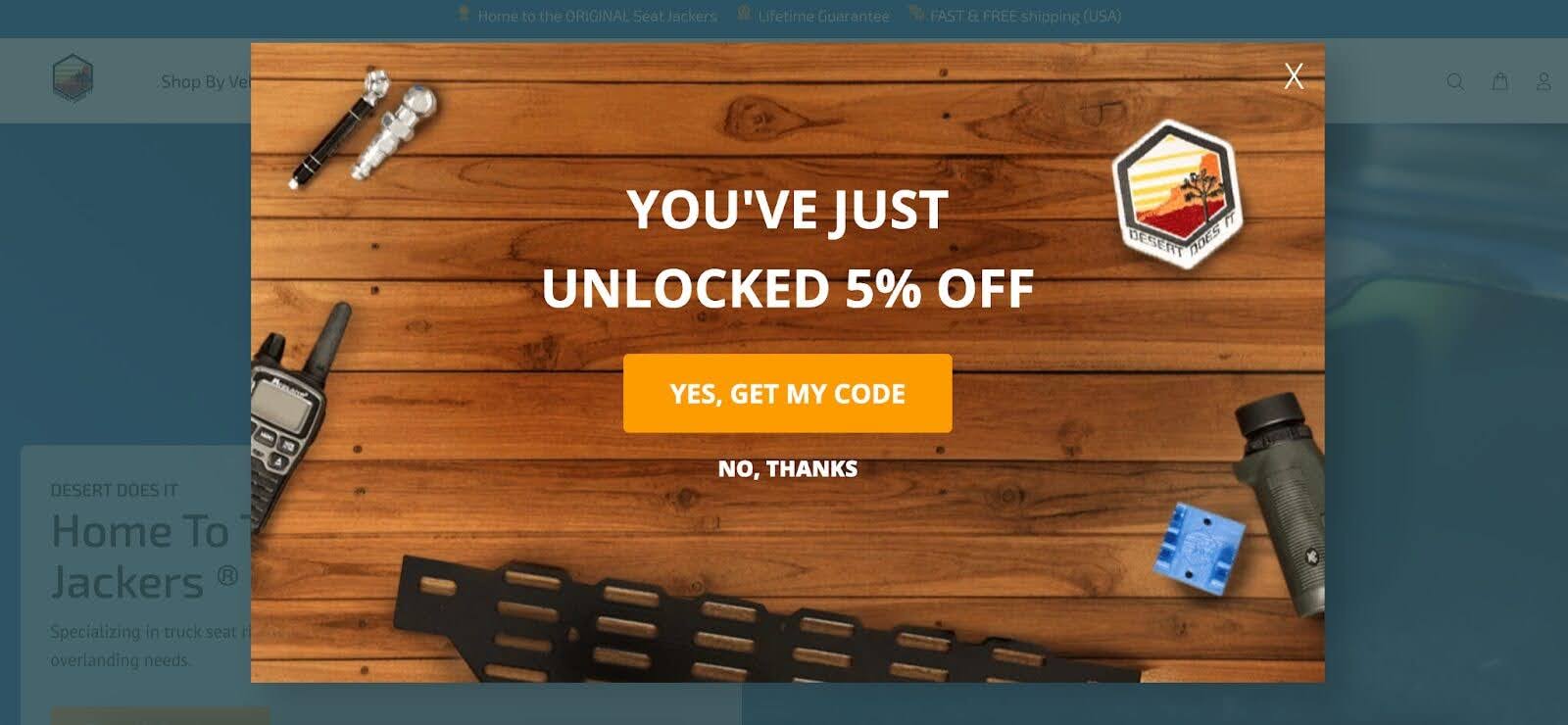
Then, they follow up with questions like, “What vehicle are you shopping for?” This helps them collect zero-party data without overwhelming users.
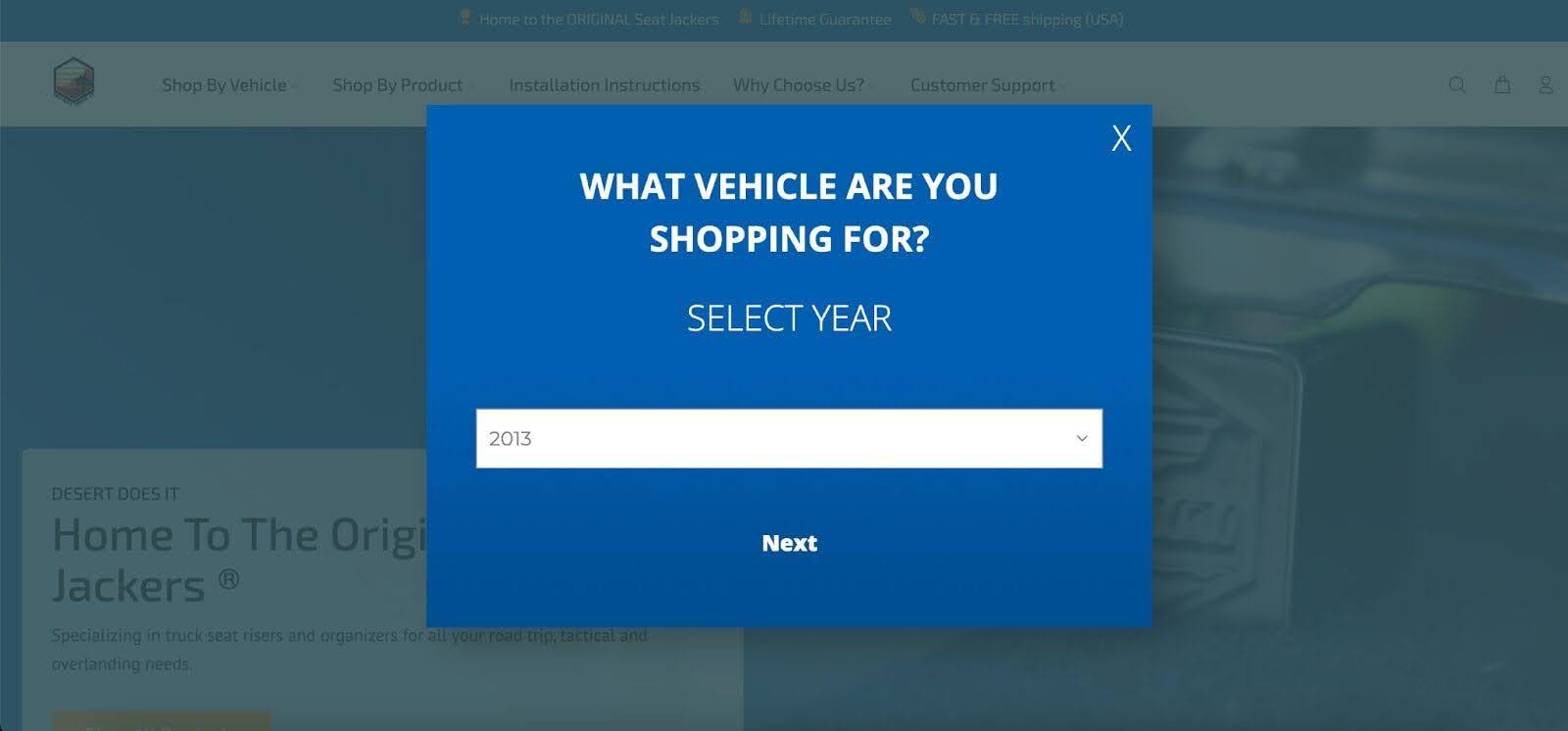
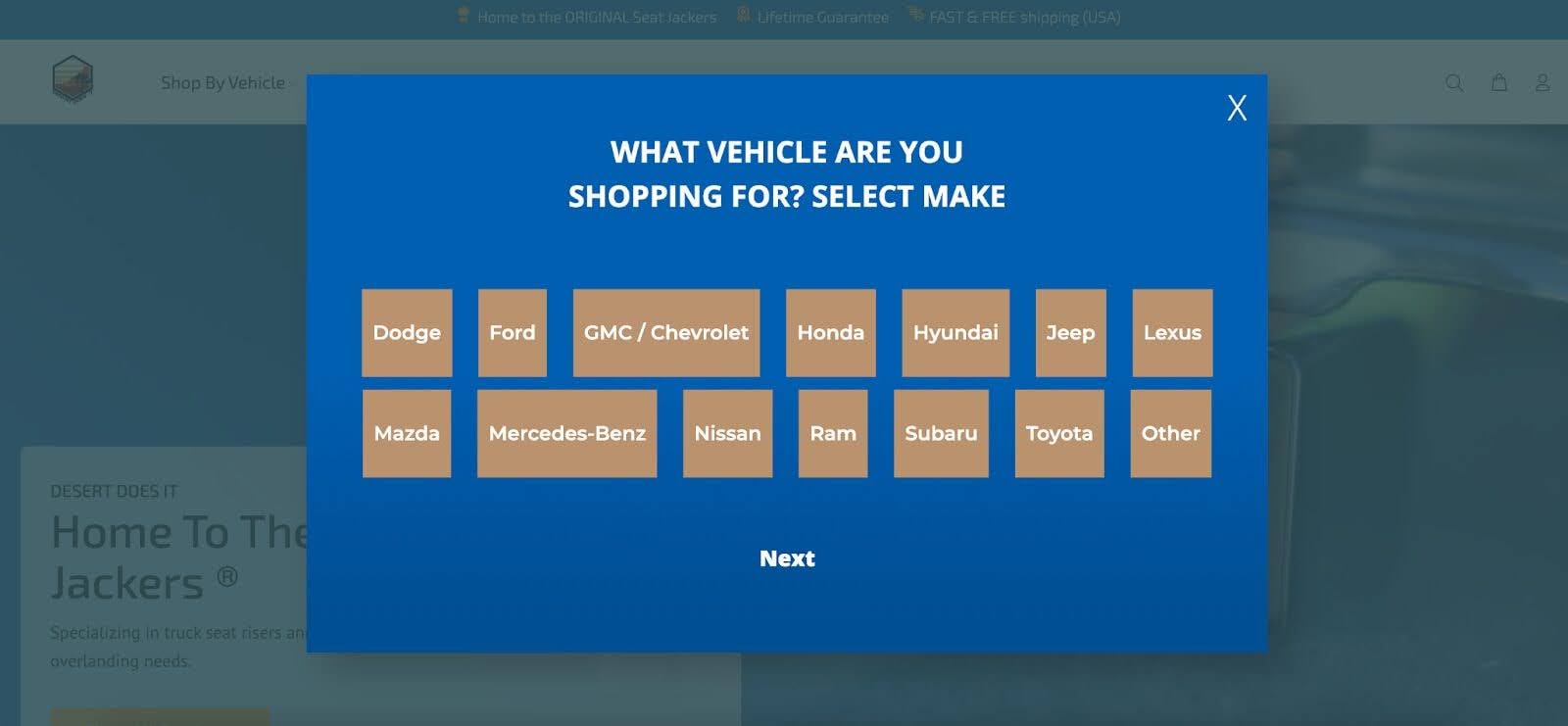
Only after this warm-up do they request an email—making the opt-in feel earned.
Learn how Desert Does It turned a quiz popup into a zero-party data goldmine.
4. Athletic Greens
You’ve probably seen AG1 from Athletic Greens everywhere—and for good reason. This premium supplement brand isn’t just selling health; they’re selling personalization.
And one of their smartest tools? A strategic quiz.
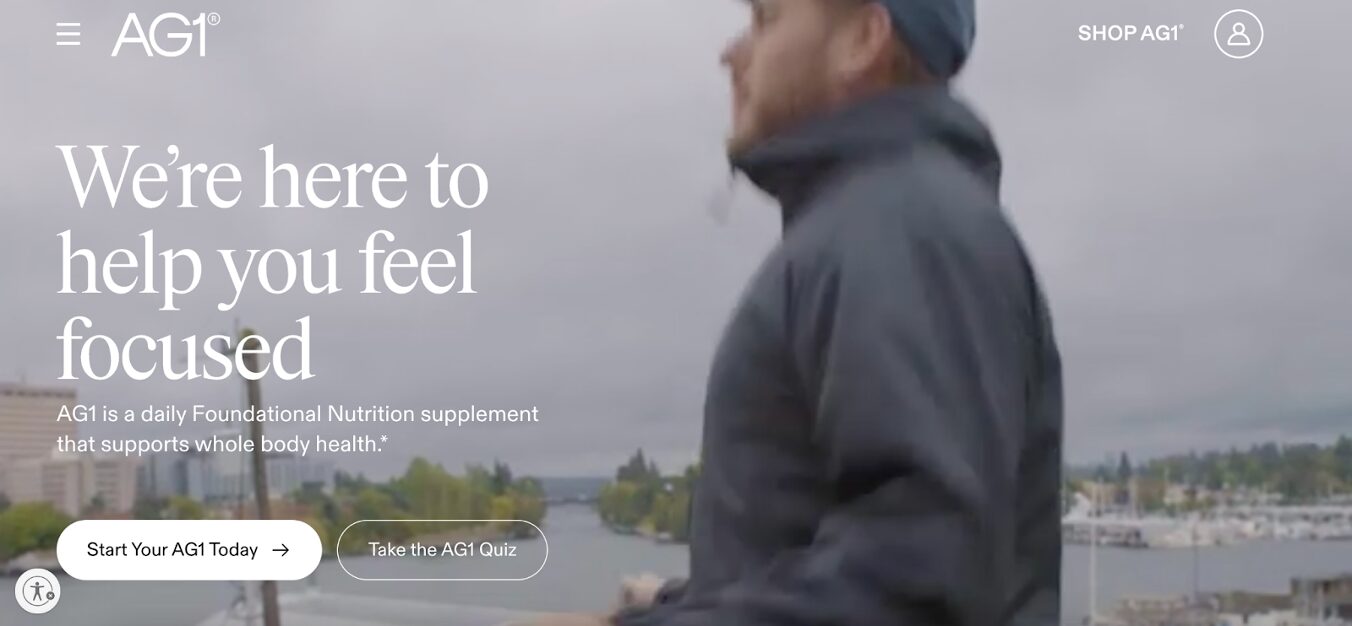
Instead of waiting for users to read through product details, Athletic Greens greets them with a popup quiz as they scroll down the homepage.
This well-timed popup grabs attention at just the right moment—when users are already a bit invested in exploring.
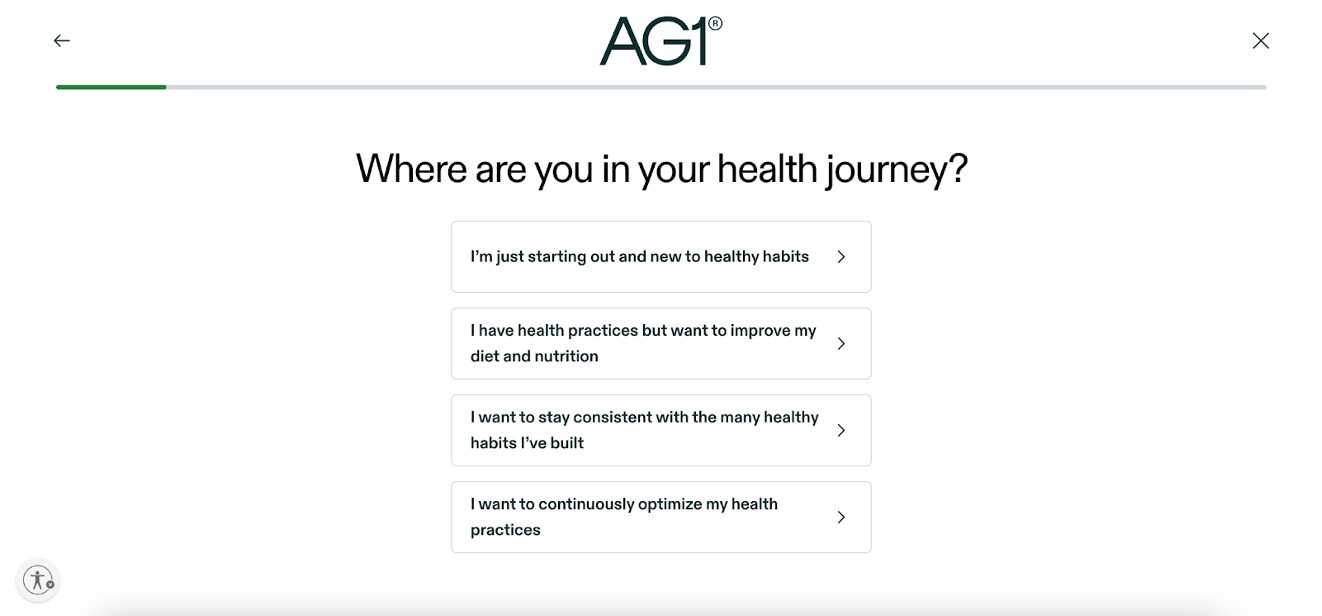
The quiz asks a few simple health-related questions, then prompts users to enter their email to view the results. It’s a smart lead-gen tactic, but more importantly, it delivers valuable insights to the customer. Win-win.
Based on these answers, users receive customized product recommendations that actually make sense for them.
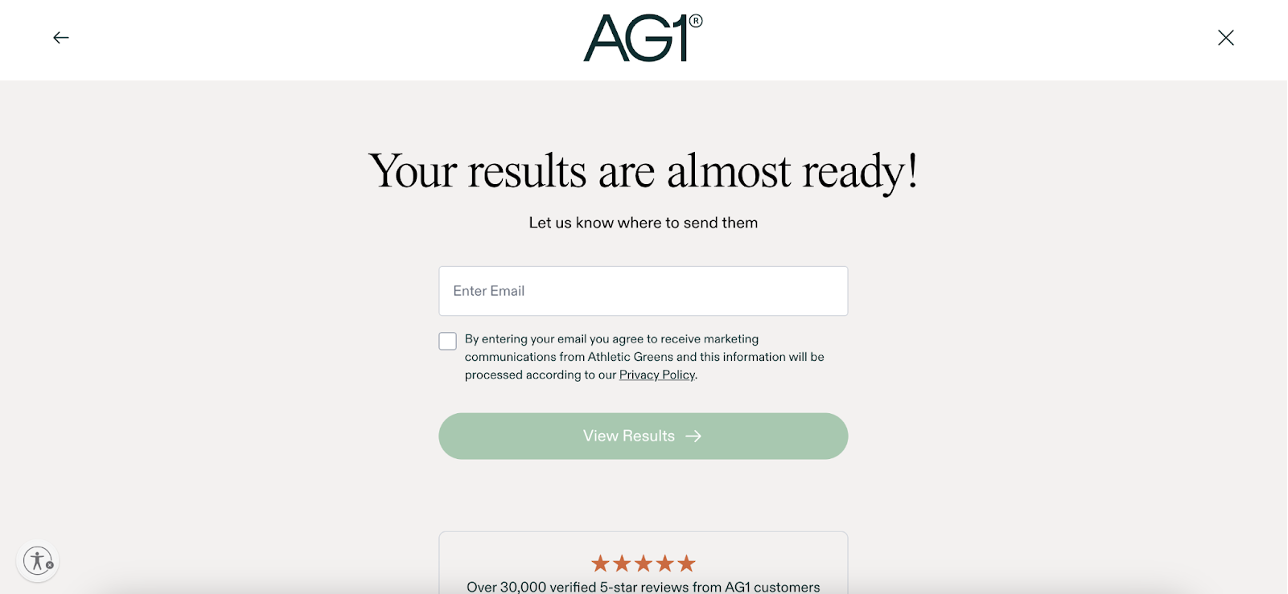
This approach not only speeds up the buying process, but also builds trust, making people feel confident in their purchase.
Discover how AG1 uses a scroll-triggered quiz to boost engagement—check out the full breakdown.
5. Kiss My Keto
Kiss My Keto’s quiz worked because it was direct, relevant, and rewarding. It opened with a question that instantly guided shoppers: “What are you looking for?”
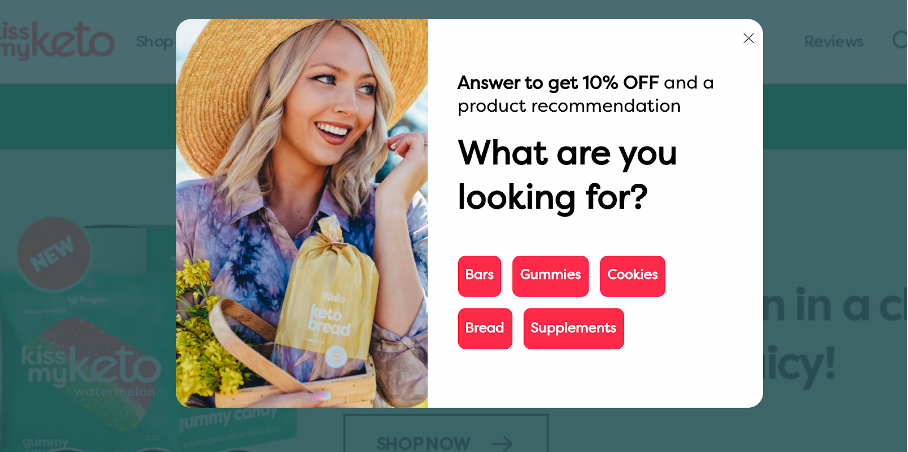
Then, it sweetened the deal with a 10% discount. This combo of clarity and incentive encouraged users to complete the quiz and share their email.
The final step delivered personalized product recommendations, removing guesswork from the buying process.
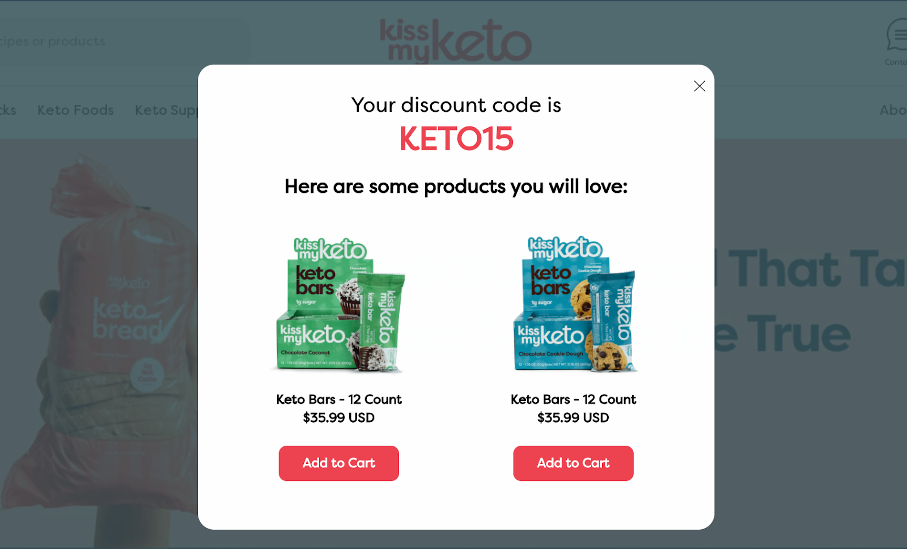
Discover how Kiss My Keto boosted conversions by guiding users with a single question.
6. Bearaby
Bearaby isn’t just cozy—they’re clever. Known for their weighted blankets, the brand uses a quiz funnel to help customers find the perfect match based on sleep style, body weight, and comfort preferences.
This personalized experience makes the shopping journey much easier and more enjoyable. Instead of overwhelming users with product choices, Bearaby guides them to what will work best for them.
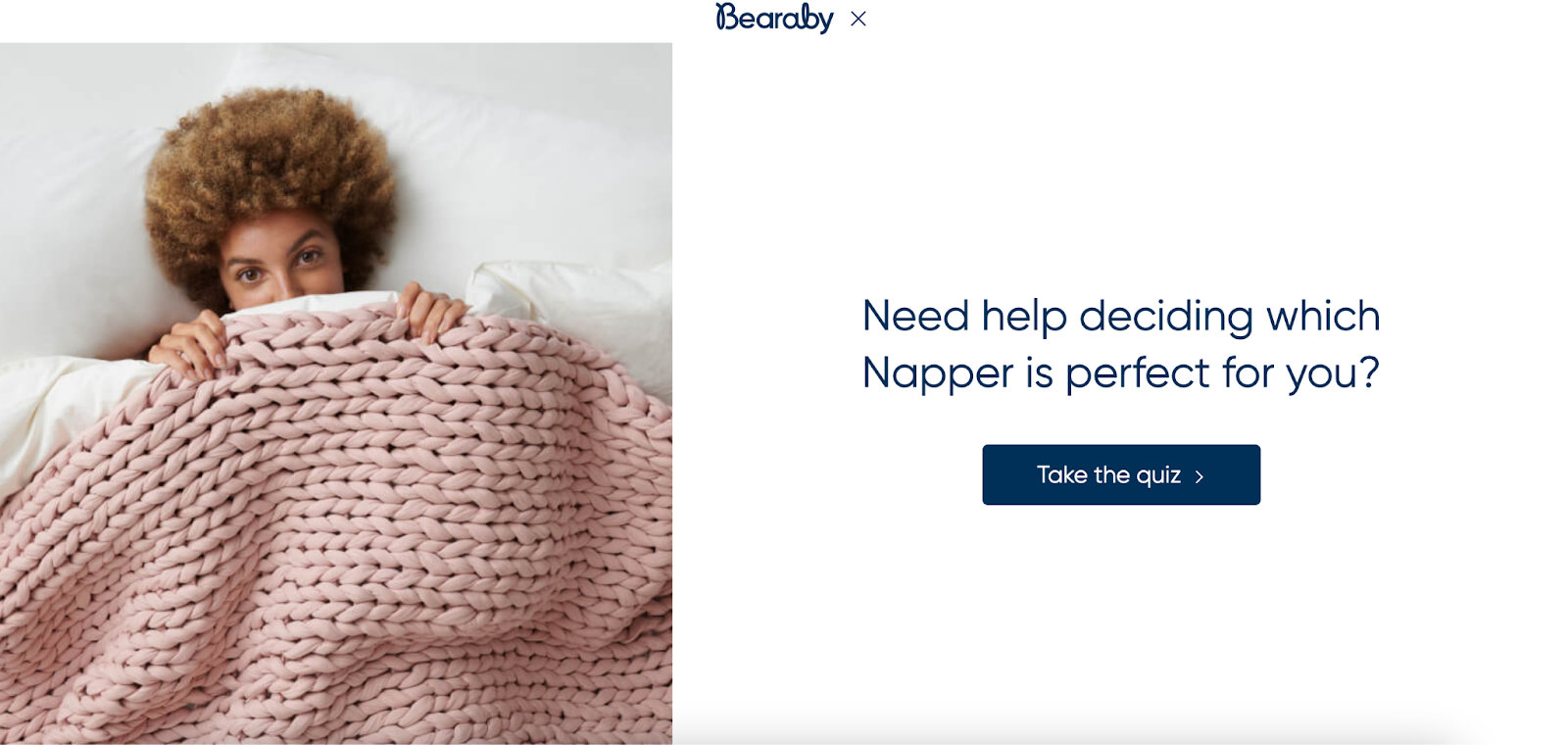
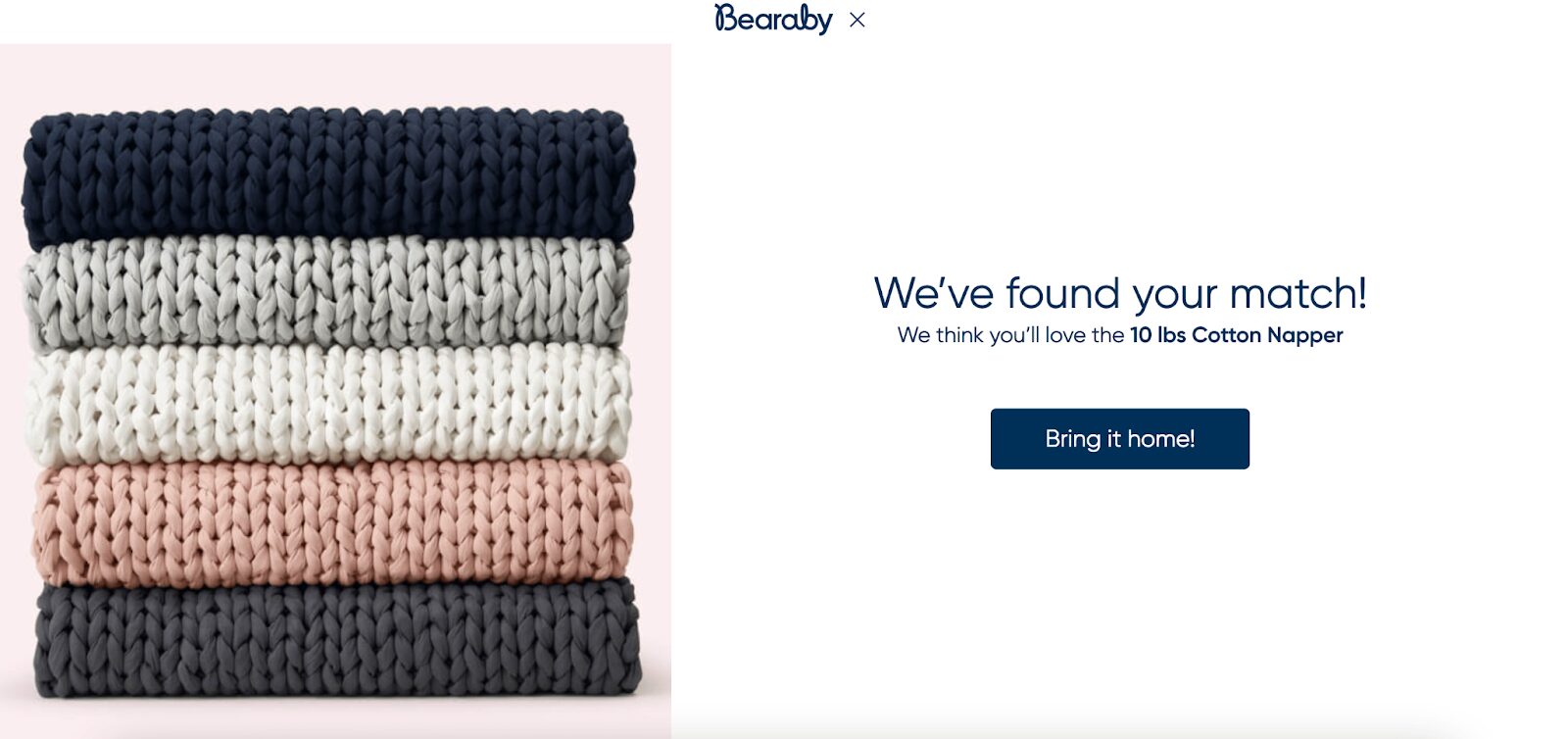
And here’s the kicker—it’s also an email goldmine. By collecting contact info at the end of the quiz, Bearaby builds its email list while optimizing its bottom-of-the-funnel ad strategy.
Want to know how Bearaby blankets their funnel with conversions? Read the strategy here.
7. Crown & Paw
Crown & Paw uses a winning formula: a strong opening incentive (10% off), a few personalized questions about pets (who doesn’t love gushing about their furry friend?), and a laid-back tone that makes it feel more like chatting than filling out a form.
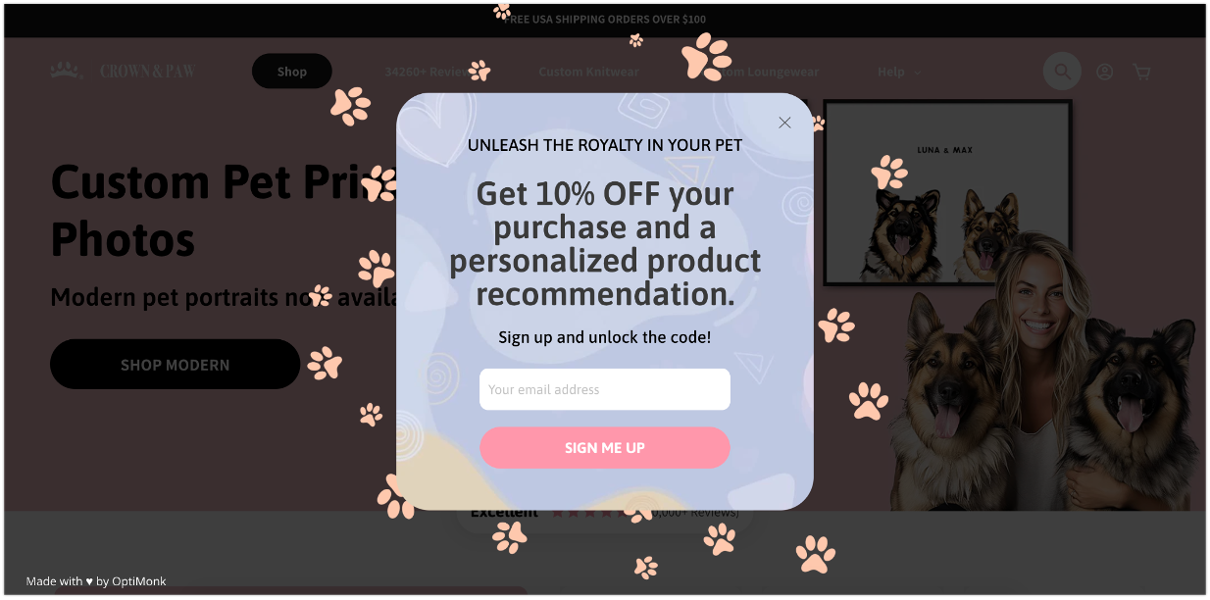
As users claim their 10% discount, ask a few quick questions to uncover their interests and preferences.
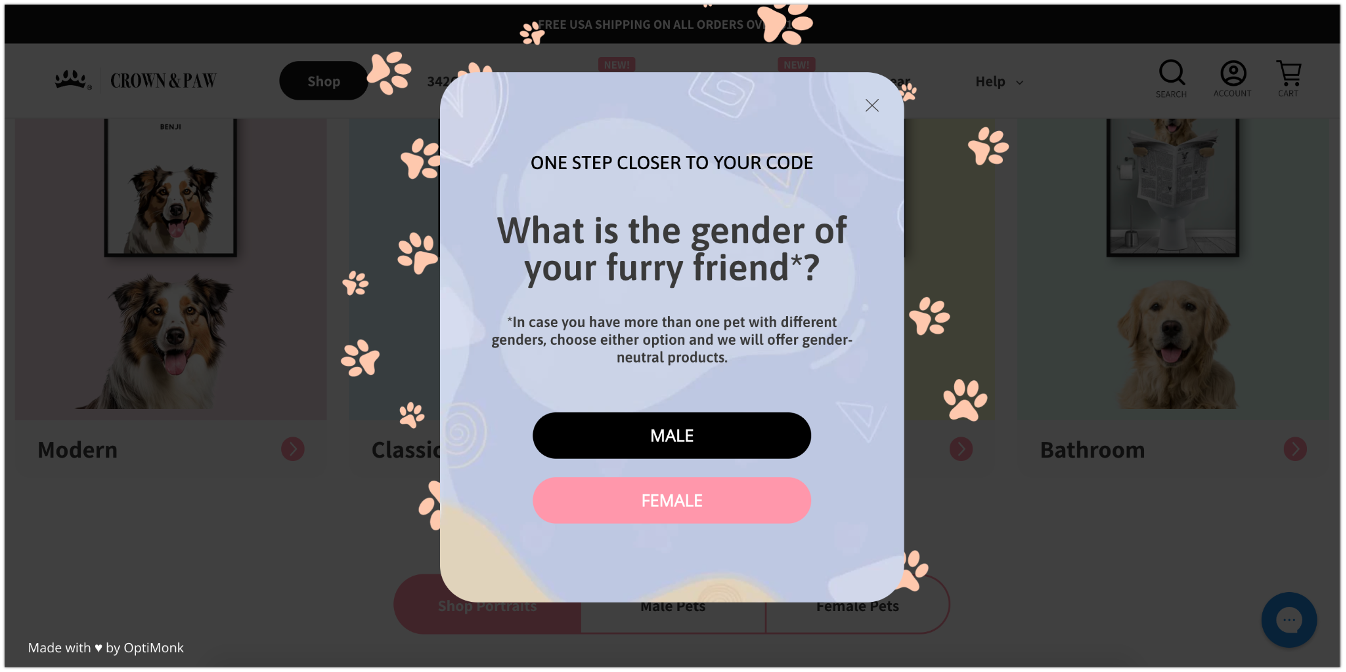
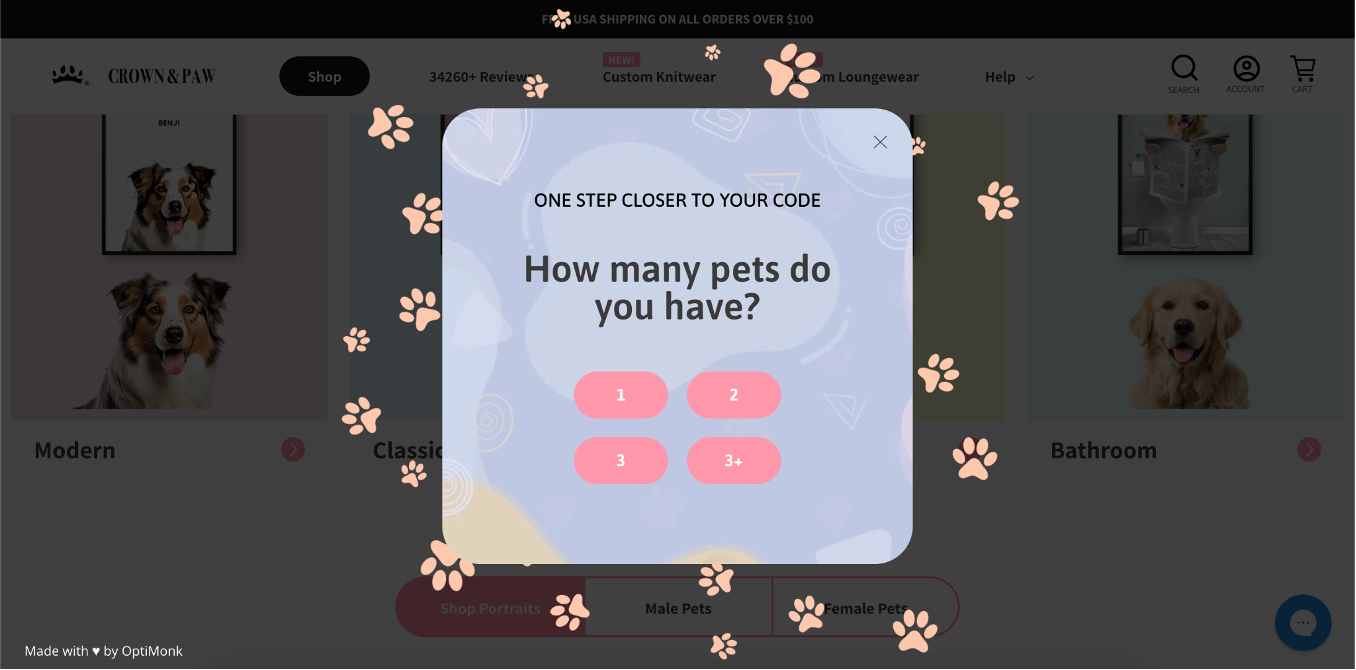
Then, wrap it up with personalized product recommendations and the discount code.
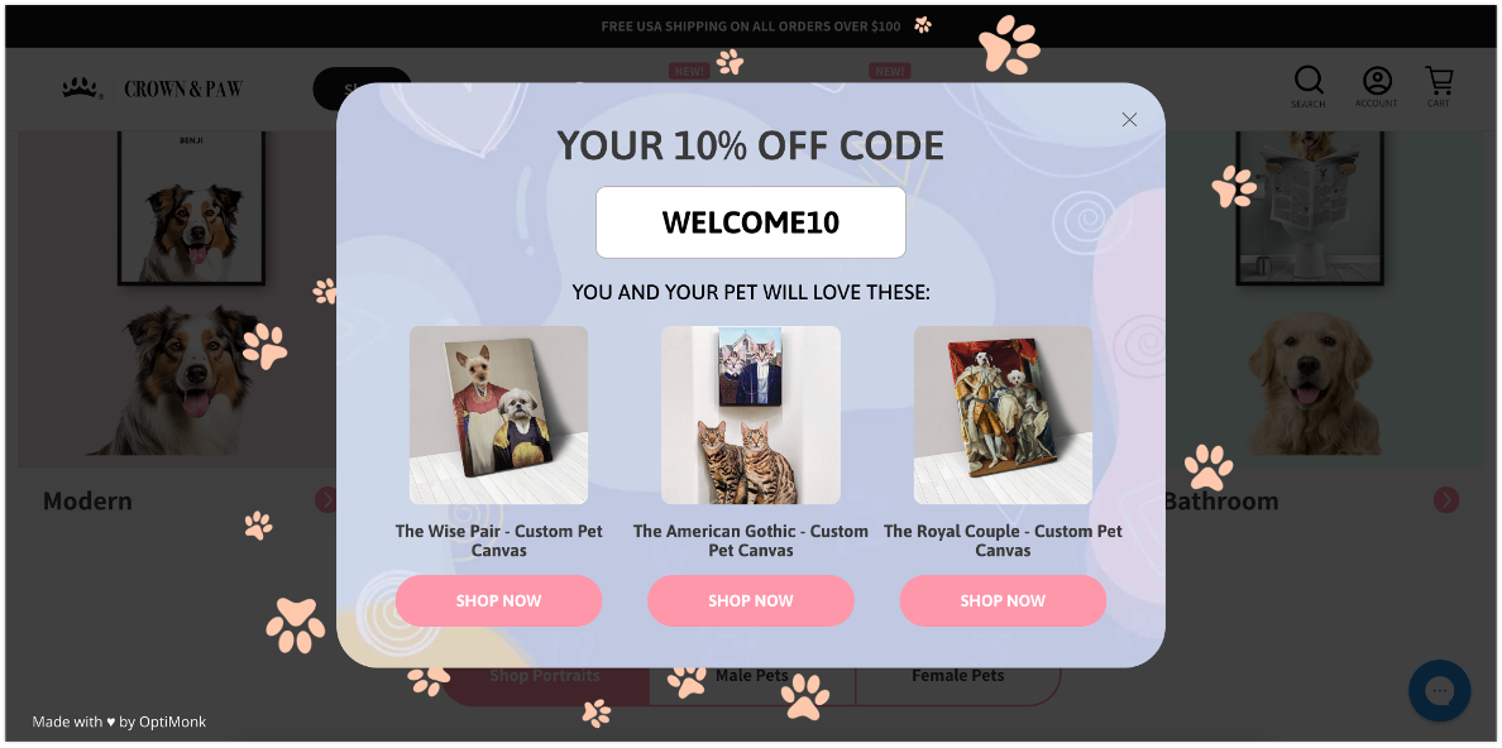
Find out how Crown & Paw turned pet lovers into loyal customers with one smart quiz.
8. Care/of
Care/of is a now-defunct supplement brand that mastered the quiz funnel. Their quiz was like a mini health consultation, asking about your diet, lifestyle, sleep habits, health goals, and even your medical history.
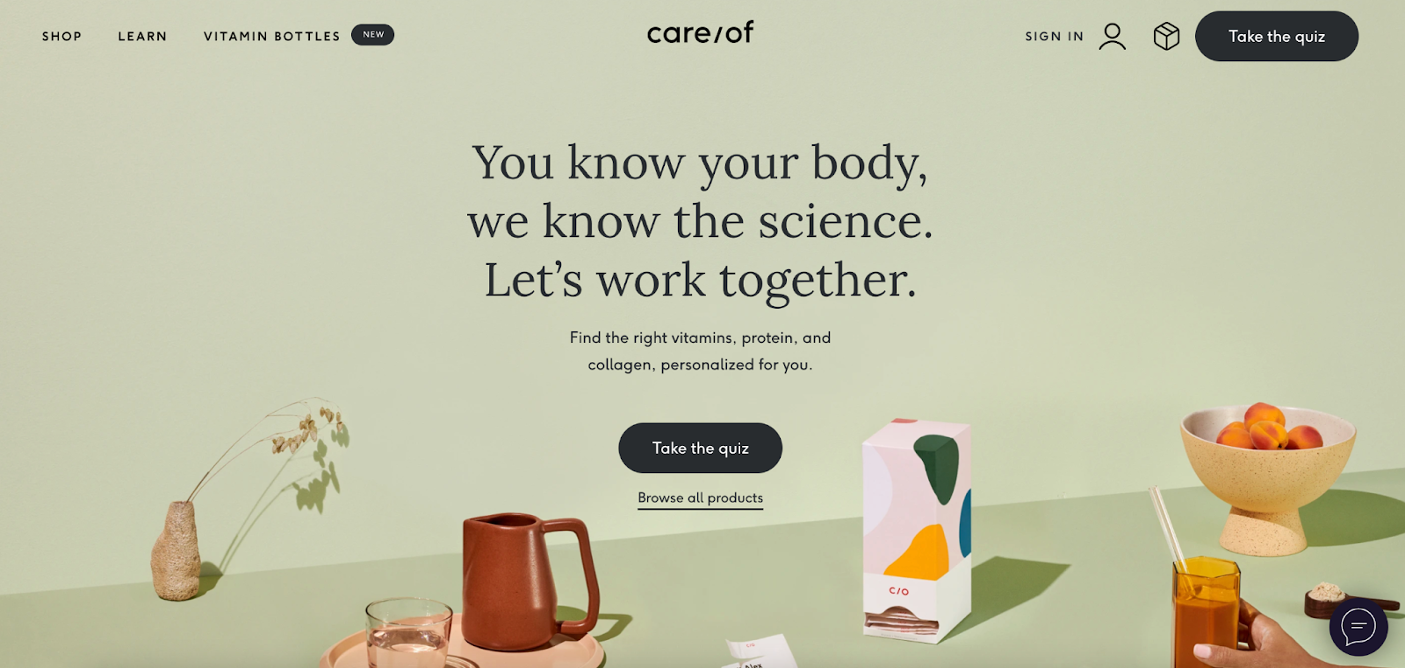
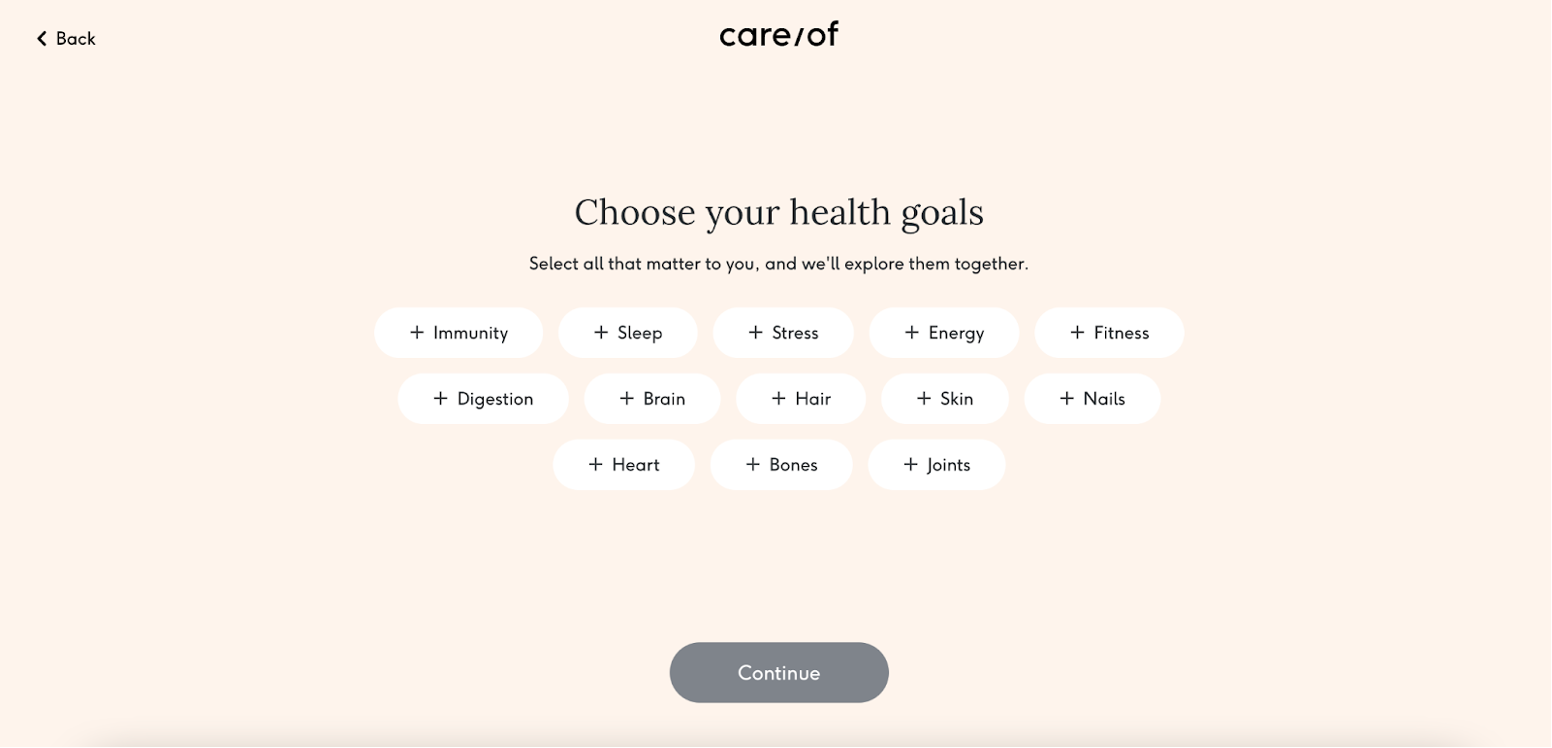
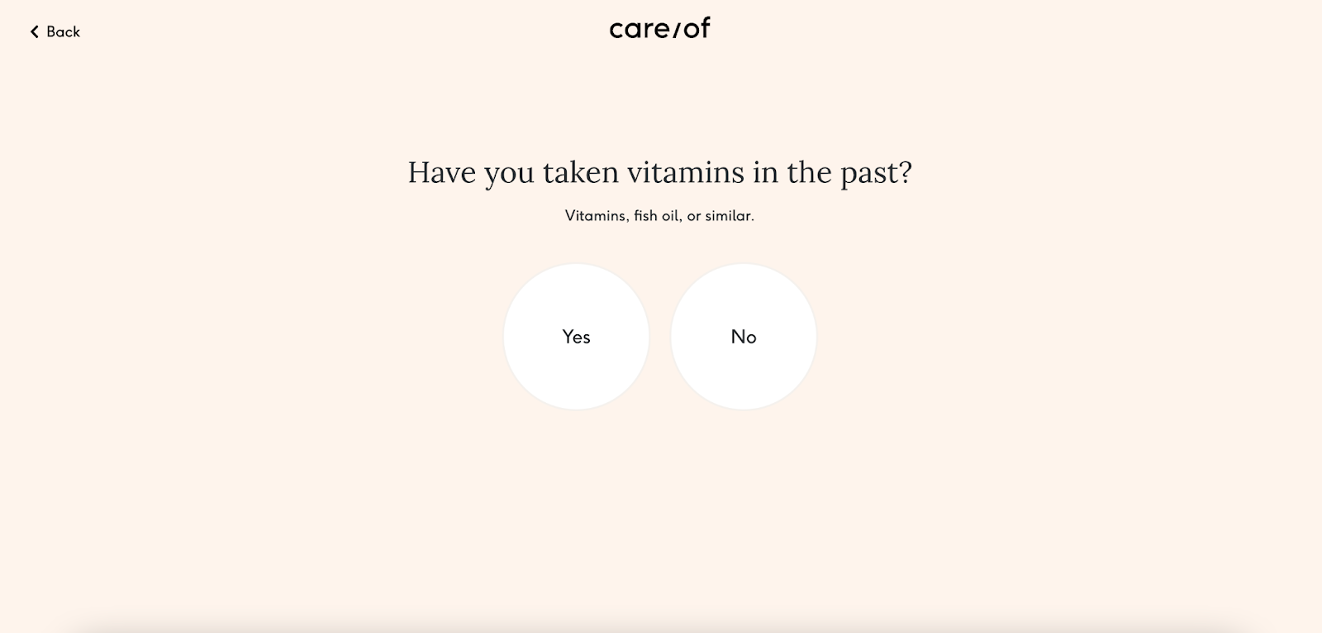
Why ask all these questions? Because the more they know, the better they can help.
After finishing the quiz, users received personalized vitamin and supplement recommendations tailored to their unique health profile. It was specific, relevant, and made the user feel genuinely cared for.
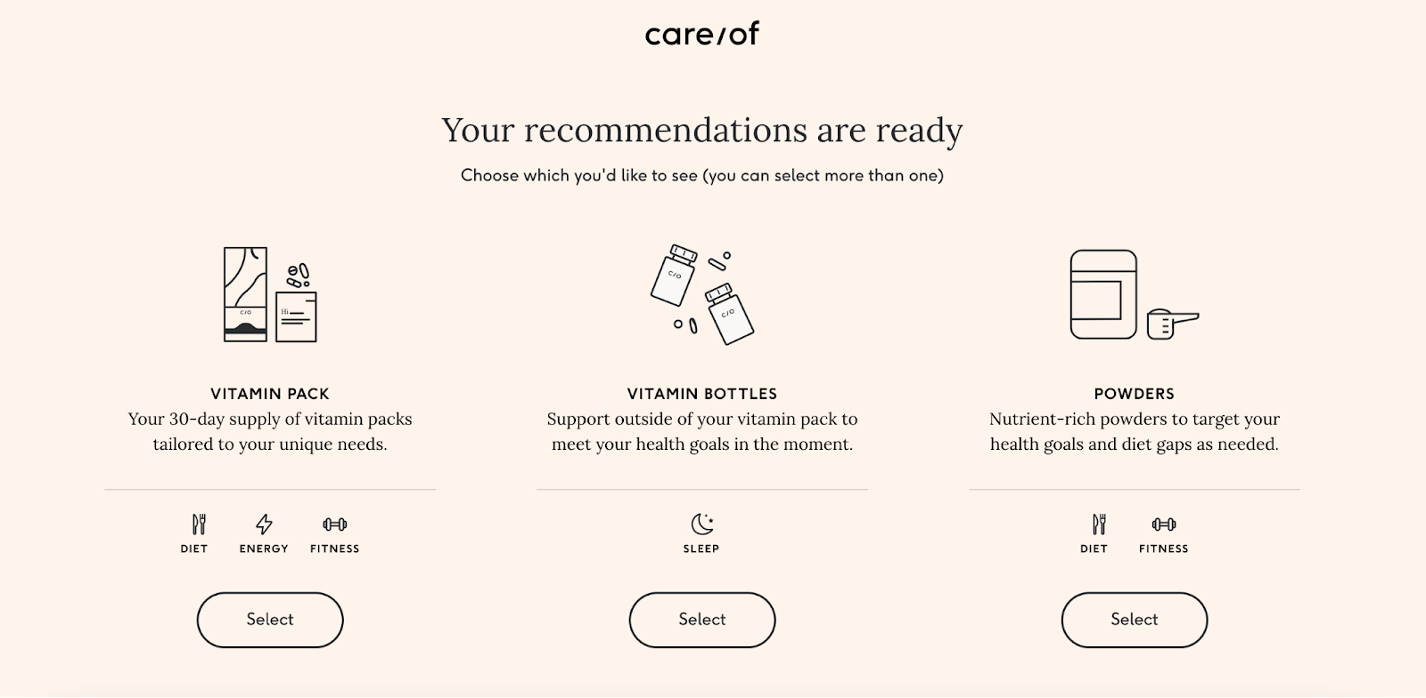
This is also a brilliant tactic for segmentation. By collecting detailed data, Care/of was able to send highly personalized follow-ups, content, and product offers.
Curious how Care/of built long-term loyalty through quizzes? Check out their full marketing breakdown here.
9. Pots, Planters & More
This brand started strong with a smart question: Are you looking for planters for your home or for a business? That single query helped them immediately tailor the experience.
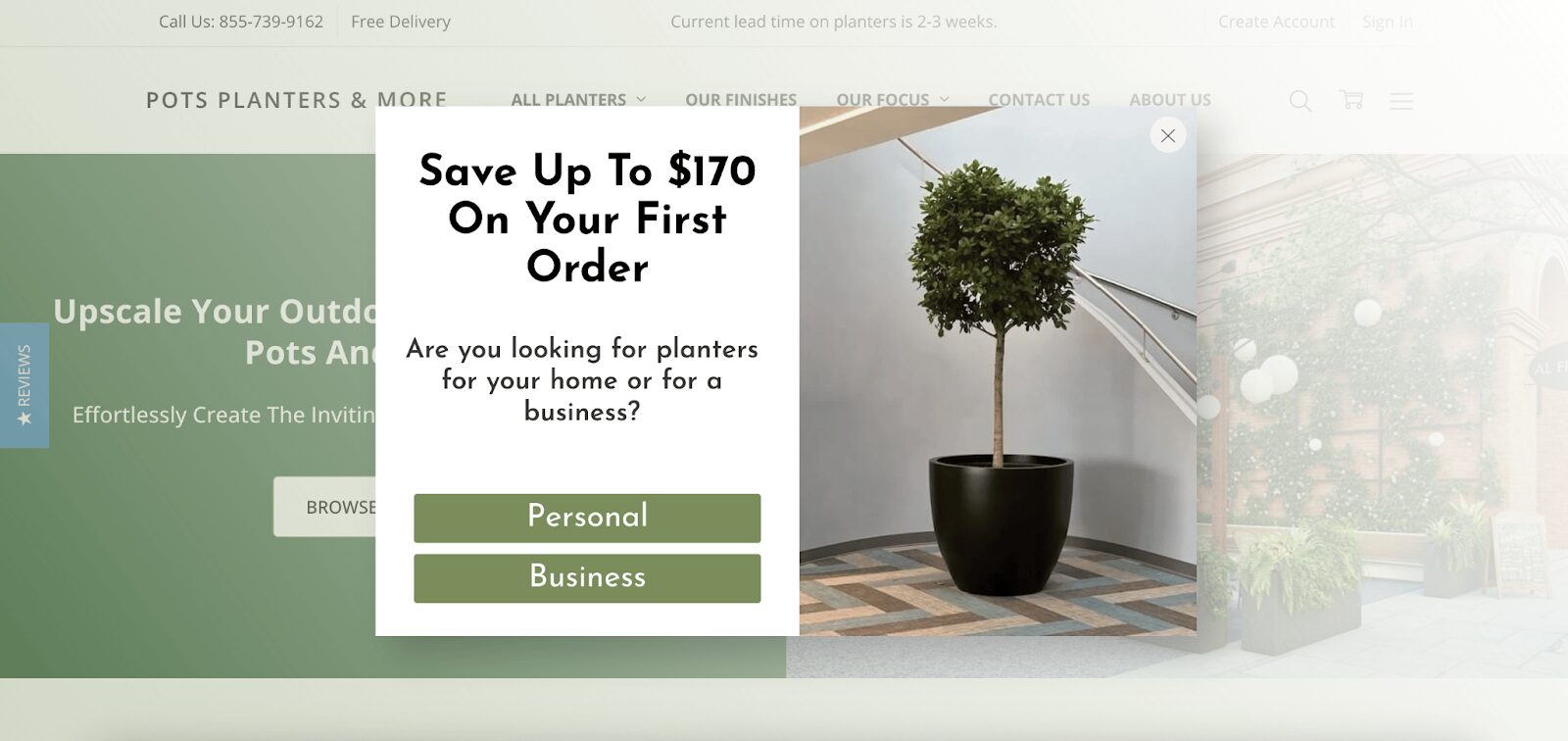
And the kicker? They paired it with a generous $170 discount for first-time buyers. That kind of value, paired with a thoughtful quiz flow and quick opt-in, made for a high-performing campaign.
See how Pots, Planters & More used segmentation and a $170 offer to skyrocket conversions.
How to create a personalization quiz with OptiMonk?
OptiMonk takes the heavy lifting out of quiz creation—no coding, no guesswork, just a smooth path from idea to launch. Here’s how to build a high-converting popup quiz in five simple steps:
Step 1. Nail down your topic
Start with a quiz topic that your audience actually cares about. It should be relevant to your product and solve a problem or answer a question your visitors are already thinking about. A good topic sets the tone and increases completion rates from the start.
Step 2. Pick your template
OptiMonk offers over 300 customizable popup templates, so you’re not starting from scratch. Choose one that fits your brand’s visual identity and works well with your site layout.
Whether you want something sleek and minimal or bold and colorful, there’s a template to match.
Step 3. Create your quiz
Use the drag-and-drop editor to bring your quiz to life. Write questions that feel conversational, add visuals for engagement, and don’t forget to include an incentive—whether it’s a discount, a freebie, or personalized results.
The goal is to make the quiz both fun and rewarding.
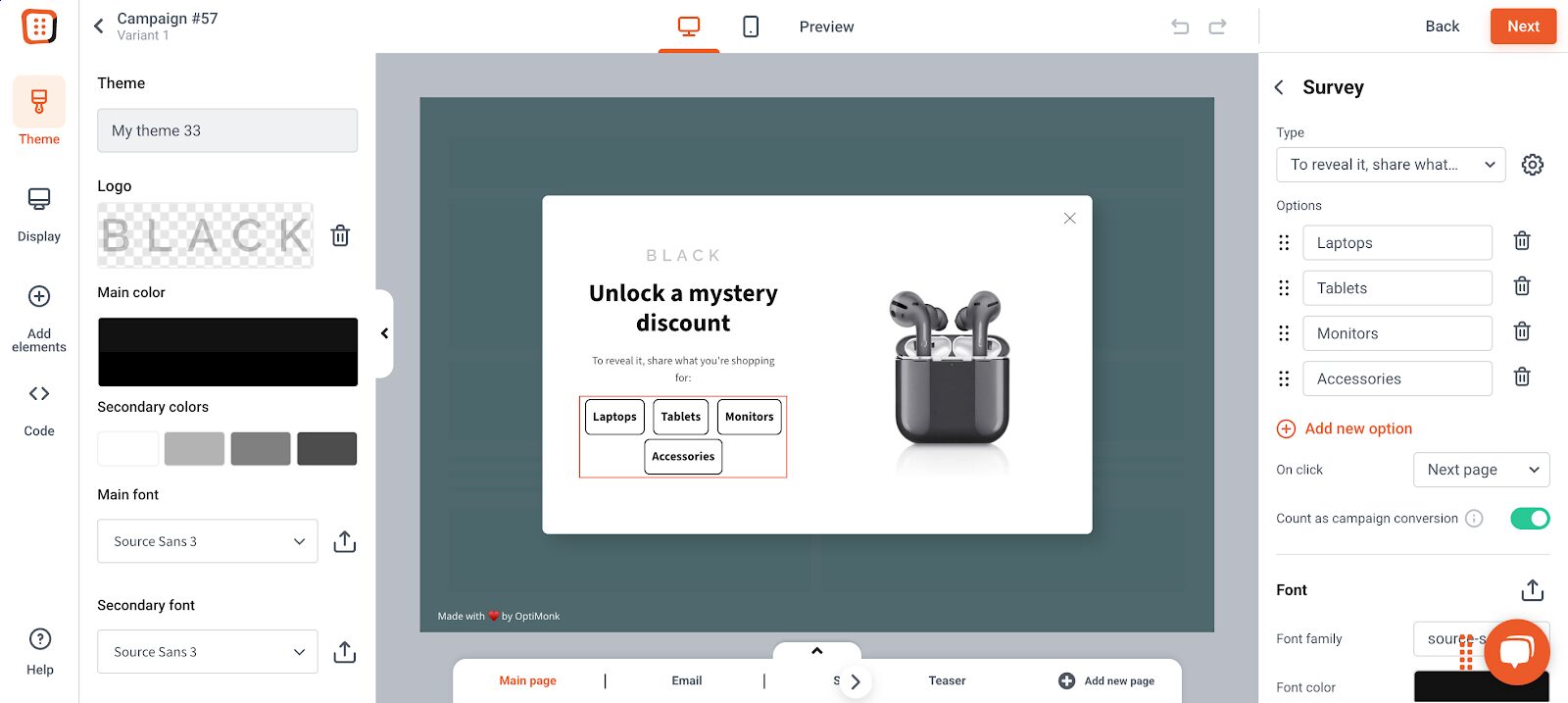
Step 4. Define your targeting
Now, decide who should see the quiz and when. OptiMonk’s targeting tools let you segment by behavior, traffic source, device type, and more.
Want to catch new visitors or recover abandoned users? Set up rules that deliver the quiz at just the right moment.
Step 5. Publish your quiz
Time to go live! But don’t stop there—you want to track the results. Monitor how users engage with your quiz, test different versions of questions or incentives, and continuously refine your strategy. The best quizzes evolve with the data.
FAQ
How many questions should a personalization quiz have?
Aim for 3 to 5 questions. That’s the sweet spot—enough to collect useful data and deliver meaningful recommendations, but short enough to keep users engaged. Go longer, and you risk losing them before they reach the finish line.
Should I offer a discount on the quiz?
Yes—if it aligns with your goals. A well-timed incentive, like 10% off, can significantly boost email opt-ins and quiz completion rates. Just make sure the offer feels like a reward, not a bribe. Tie it to the quiz results for a more seamless experience.
Can I collect emails without annoying users?
Absolutely. The key is timing and value. Ask for the email after you’ve provided a bit of interaction or insight—like right before revealing the results. If users see they’re getting something valuable (personalized tips, exclusive offers), they’re much more likely to opt in willingly.
Wrapping up
Personalization quizzes aren’t just trendy—they’re conversion magnets.
They help you learn more about your audience, provide tailored experiences, and grow your email list without feeling intrusive. Whether you’re selling supplements or planters, quizzes offer a scalable way to humanize your customer journey.
So go on—ask a few questions. You’ll be surprised how many people are happy to answer.
Want help getting started? OptiMonk’s got your back. Start your free account today!
Migration has never been easier
We made switching a no-brainer with our free, white-glove onboarding service so you can get started in the blink of an eye.
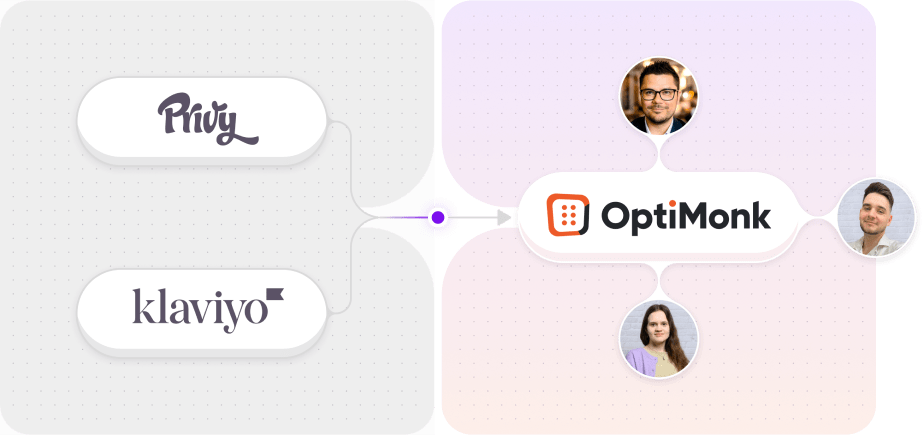
What should you do next?
Thanks for reading till the end. Here are 4 ways we can help you grow your business:
Boost conversions with proven use cases
Explore our Use Case Library, filled with actionable personalization examples and step-by-step guides to unlock your website's full potential. Check out Use Case Library
Create a free OptiMonk account
Create a free OptiMonk account and easily get started with popups and conversion rate optimization. Get OptiMonk free
Get advice from a CRO expert
Schedule a personalized discovery call with one of our experts to explore how OptiMonk can help you grow your business. Book a demo
Join our weekly newsletter
Real CRO insights & marketing tips. No fluff. Straight to your inbox. Subscribe now
Barbara Bartucz
- Posted in
- Conversion
Partner with us
- © OptiMonk. All rights reserved!
- Terms of Use
- Privacy Policy
- Cookie Policy

